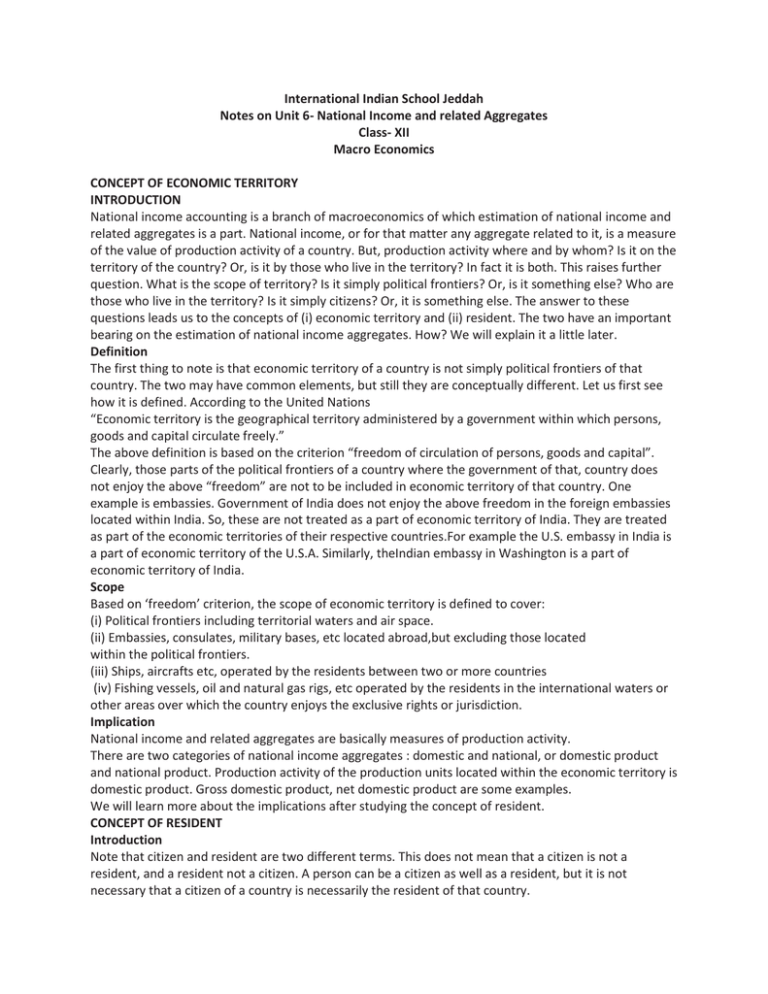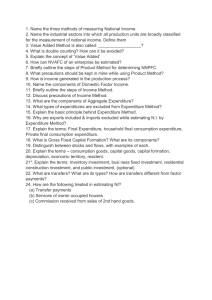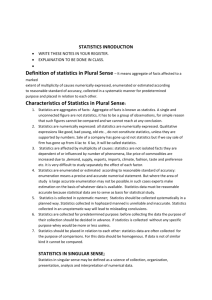File
advertisement

International Indian School Jeddah Notes on Unit 6- National Income and related Aggregates Class- XII Macro Economics CONCEPT OF ECONOMIC TERRITORY INTRODUCTION National income accounting is a branch of macroeconomics of which estimation of national income and related aggregates is a part. National income, or for that matter any aggregate related to it, is a measure of the value of production activity of a country. But, production activity where and by whom? Is it on the territory of the country? Or, is it by those who live in the territory? In fact it is both. This raises further question. What is the scope of territory? Is it simply political frontiers? Or, is it something else? Who are those who live in the territory? Is it simply citizens? Or, it is something else. The answer to these questions leads us to the concepts of (i) economic territory and (ii) resident. The two have an important bearing on the estimation of national income aggregates. How? We will explain it a little later. Definition The first thing to note is that economic territory of a country is not simply political frontiers of that country. The two may have common elements, but still they are conceptually different. Let us first see how it is defined. According to the United Nations “Economic territory is the geographical territory administered by a government within which persons, goods and capital circulate freely.” The above definition is based on the criterion “freedom of circulation of persons, goods and capital”. Clearly, those parts of the political frontiers of a country where the government of that, country does not enjoy the above “freedom” are not to be included in economic territory of that country. One example is embassies. Government of India does not enjoy the above freedom in the foreign embassies located within India. So, these are not treated as a part of economic territory of India. They are treated as part of the economic territories of their respective countries.For example the U.S. embassy in India is a part of economic territory of the U.S.A. Similarly, theIndian embassy in Washington is a part of economic territory of India. Scope Based on ‘freedom’ criterion, the scope of economic territory is defined to cover: (i) Political frontiers including territorial waters and air space. (ii) Embassies, consulates, military bases, etc located abroad,but excluding those located within the political frontiers. (iii) Ships, aircrafts etc, operated by the residents between two or more countries (iv) Fishing vessels, oil and natural gas rigs, etc operated by the residents in the international waters or other areas over which the country enjoys the exclusive rights or jurisdiction. Implication National income and related aggregates are basically measures of production activity. There are two categories of national income aggregates : domestic and national, or domestic product and national product. Production activity of the production units located within the economic territory is domestic product. Gross domestic product, net domestic product are some examples. We will learn more about the implications after studying the concept of resident. CONCEPT OF RESIDENT Introduction Note that citizen and resident are two different terms. This does not mean that a citizen is not a resident, and a resident not a citizen. A person can be a citizen as well as a resident, but it is not necessary that a citizen of a country is necessarily the resident of that country. A person can be a citizen of one country and at the same time a resident of another country. For example a NRI, Non-resident Indian. A NRI is citizen of India but a resident of the country in which he lives. Citizenship is basically a legal concept based on the place of birth of the person or some legal provisions allowing a person to become a citizen. On the other hand resident ship is basically an economic concept based on the basic economic activities performed by a person. Definition A resident is defined as follows: A resident, whether a person or an institution, is one whose centre of economic interest lies in the economic territory of the country in which he lives. The ‘centre of economic interest’ implies two things: (i) the resident lives or is located within the economic territory and (ii) the resident carries out the basic economic activities of earnings, spending and accumulation from that location Implications Production activity of the residents of an economic territory is national product. GNP, NNP, are some examples. National product includes production activities of residents irrespective of whether performed within the economic territory or outside it. In comparison, domestic product includes production activity of the production units located in the economic territory irrespective of whether carried out by the residents or non-residents. Relation between national product and domestic product The concept of domestic product is based on the production units located within economic territory, operated both by residents and non-residents. The concept of national product is based on residents, and includes their contribution to production both within and outside the economic territory. Normally, in practical estimates, domestic product is estimated first. National product is then derived from the domestic product by making certain adjustments. Let us see how? National product is derived in the following way: National product = Domestic product + residents contribution to production outside the economic territory - non-residents contribution to production inside the economic Territory In practical estimates the resident’s contribution outside the economic territory is called “factor income received from abroad”. The non-residents’ contribution inside the economic territory is called “factor income paid to residents”. Therefore, National product = Domestic product + Factor income received from abroad - Factor income paid to abroad. Factor income received from abroad’ is added to domestic product because this contribution of residents is in addition to their contribution to domestic product. ‘Factor income paid to abroad ‘is subtracted because this part of domestic product, does not belong to the residents. By subtracting factor income paid’ from “factor income received” from abroad, we get a net figure “Net factor income from abroad” popularly abbreviated as NFIA. National product = Domestic product + Net factor income from abroad = Domestic product + NFIA INDUSTRIAL CLASSIFICATION Introduction It means grouping production units into distinct industrial groups, or sectors. This is the first step required to be taken in estimating national income, irrespective of the method of estimation. It is statistically more convenient to estimate national income originating in a group of similar production units rather than for each production unit separately. It is now a matter of general practice to group all the production units of the economic territory into three broad groups : primary sector, secondary sector and tertiary sectors. Each of these sector can be further subdivided into smaller groups depending upon the requirement. Let us now explain each sector. Primary Sector Primary sector includes production units exploiting natural resources like land, water, subsoil assets, etc. Growing crops, catching fish, extracting minerals, animal husbandry, forestry, etc.are some examples. Primary means of first importance’. It is primary because it is a source of basic raw materials for the secondary sector. Secondary Sector Secondary sector includes production units which are engaged in transforming one good into another good. Such an activity is called manufacturing activity. These units convert raw materials into finished goods. Factories, construction, power generation, water supply are the examples. It is called secondary because it is dependent upon the primary sector for raw materials. Tertiary Sector Tertiary sector includes production units engaged in producing services. Transport, trade education, hotels and restaurant, finance, government administration, etc are some examples. This sector finds third place because its growth is primarily dependent on the primary and secondary sectors. NATIONAL INCOME AGGREGATES There are many aggregates in national income accounting. The basic among these is Gross Domestic Product at Market Price (GDPmp). By making adjustments in GDPmp, we can derive other aggregates like Net Domestic product at Market Price (NDPmp) and NDP at factor cost (NDPfc). Net Domestic Product Why is GDPmp called gross? GDPmp is final products valued at market price. This is what buyers pay. But this is not what production units actually receive. Out of what buyers pay the production units have to make provision for depreciation and payment of indirect tax like excise, sales tax, etc. This explains why GDPmp is called ‘gross’. It is called gross because no provision has been made for depreciation. However, if depreciation is deducted from the GDP, it becomes Net Domestic Product (NDP). Therefore, GDPmp - depreciation = NDPmp Domestic product at Factor Cost Why is GDPmp called ‘at market price’? Out of what buyers pay, the production units have to make payments of indirect taxes,if any. Sometimes production units receive subsidy on production. This is in addition to the market price which production units receive from the buyers. Therefore what production units actually receive is not the ‘market-price’ but “market price - indirect tax + subsidies” This is what is actually available to production units for distribution of income among the owners of factors of production. Therefore, Market price - indirect tax (I.T.) + subsidies = Factor payments (or factor costs) By making adjustment of indirect tax and subsidies we derive GDP at factor cost (GDPfc) from GDPmp.. GDPmp I.T. + subsidies = GDPfc or GDP - net I.T. = GDPfc Net Domestic Product at Factor Cost If we make adjustment of both the net I.T and depreciation (also called consumption of fixed capital) we get one more aggregate called Net Domestic Product at Factor Cost (NDPfc) GDPmp - I.T. + Sub-depreciation = NDPfc. or NDPfc+ I.T. - Sub+depreciation = GDPmp Net National Product at Factor Cost (NNPfc) or National Income Net factor income from abroad (NFIA) provides the link between NDP and NNP. Therefore, NDPfc + NFIA = NNPfc or NNPfc - NFIA = NDPfc Similarly, NDPmp + NFIA = NNPmp GDPmp + NFIA = GNPmp Summing up The three crucial adjustments required for deriving one aggregate from the other are: Gross - depreciation = Net Market price - I.T. + Subsidies = Factor cost Domestic + NFIA = National METHODS OF ESTIMATION OF NATIONAL INCOME (N.I.) AND OTHER RELATED AGGREGATES There are three methods of estimation of national income : production (value added), income-distribution and final expenditure methods. You are familiar with the various steps required to be taken in each. Let us see what aggregates are arrived through each method. (I) Production method (value added method) In this method we first find out Gross Value Added at Market Price (GVAmp) in each sector and then take their sum to arrive at GDPmp Sum total of GVAmp by all the sectors = GDPmp Then we make adjustments to arrive at national income or NNPfc GDPmp - Consumption of fixed capital = NDPmp NDPmp - I.T. + Subsidies = NDPfc NDPfc + NFIA = NNPfc (2) Income distribution method In this method we first estimate factor payments by each sector. The sum of such factor Payments equal Net value Added at Factor Cost (NVAfc) by that sector. Then we take sum total of NVAfc by all the sectors to arrive at NDPfc. The components of NDPfc are: 1. Compensation of employees 2. Rent and royalty 3. Interest 4. Profits System of National Accounts 1993, a joint publication of the United Nations and the World Bank,has elaborated the above components and recommended their use by all the countries in preparing national income estimates. Compensation of employees is defined as: the total remuneration in cash or in kind, payable by an enterprise to an employee in return for work done by the latter during the accounting period. The main components of compensation of employees are: (1) Wages and salaries (a) in cash (b) in kind (2) Social security contributions by the employers Rent is defined as the amount receivable by a landlord from a tenant for the use of land. Royalty is defined as the amount receivable by the landlord for granting the leasing rights of subsoil assets. Interest is defined as the amount payable to the owners of financial assets in the production unit. The production unit uses these assets for production and in turn makes interest payment, imputed or actual. Profit is a residual factor payment to the owners of a production unit. The production unit uses profit for (i) payment of corporation tax, (ii) dividend payments and (iii) undistributed profits/ retained earnings. The main source of factor payments is the accounts of production units. Since accounts of most production units are not available to the estimators, and also since the accounting practices differ, it is not possible for the estimators to clearly identify the components. Therefore, in cases where total factors payment is estimable but not its different components, an additional factor payment item called ‘mixed income’ is added. Since this problem arises mainly in case of self-employed people like doctors, chartered accountants, consultants, etc, this factor payment is popularly called “mixed income of the self employed”. NDPfc = Compensation of employees + Rent and royalty + Interest + Profit + Mixed income (if any) There is another term used in factor payments. It is ‘operating surplus’. It is defined as the sum of rent and royalty, interest and profits. In that case then: NDPfc = Compensation of employees + operating surplus + mixed income (if any) Once we estimate NDPfc, we can find NNPfc, or national income, by adding NFIA. NDPfc + NFIA = NNPfc. (3) Final expenditure method In this method we take the sum of final expenditures on consumption and investment. This sum equals GDPmp. These final expenditures are on the output produced within the economic territory of the country. Its main components are: GDPmp = Private final Consumption expenditure (PFCE) + Government final onsumption Expenditure (GFCE) + Gross domestic Capital formation (GDCF) + Net exports (= export - imports) (X-M) By making the usual adjsutments we can arrive at national income PFCE + GFCE + GDCF + (X-M) = GDPmp NDPmp = GDP MP - Consumption of fixed capital NDP fc= NDPmp + subsidies – indirect taxes NNPfc = NDPfc+ NFIA Note that GDCF is composed of the following: GDCF= Net domestic fixed capital formation + Closing stock - Opening stock + Consumption of fixed capital Also note that. ‘Clossing stock - opening stock ‘ equals net change in stocks. PRECAUTIONS IN MARKING ESTIMATES OF NATIONAL INCOME There are a large number of conceptual and statistical problem that arise in estimating national income of a country. To minimize error, it is necessary that certain precautions are taken in advance. Some of the method wise precautions are: (1) Value added (Production) method (i) Avoid double counting Value added equals value of output less intermediate cost. There is a possibility that instead of counting ‘value added’ one may count value of output. You can verify by taking some imaginary numerical example that counting only values of output will lead to counting the same output more than once. This will lead to overestimation of national income. There are two alternative ways of avoiding double counting: (a) count only value added and (b) count only the value of final products. (ii) Do not include sale of second hand goods. Sale of the used goods is not a production activity. The good should not treated as fresh production, and therefore doesn’t should not treated as fresh production, and therefore doesn’t qualify for inclusion in national income however, any brokerage or commission paid to facilitate the sale is a fresh production activity. It should be included in production but to the extent of brokerage or commission only. (iii) Self-consumed output must be included. Output produced but retained for self-consumption, rather than selling in market, is output and must be included in estimates. Services of owner-occupied buildings, farmer consuming its own produce, etc are some examples. (2) Income distribution method (i) Avoid transfers National income includes only factor payments, i.e. payment for the services rendered to the production units by the owners of factors. Any payment for which no service is rendered is called a transfer, and not a production activity. Gifts, donations, characters, etc are main examples. Since transfers are not a production activity it must not be included in national income. (ii) Avoid capital gain Capital gain refers to the income from the sale of second hand goods and financial assets. Income from the sale of old cars, old house, bonds, debentures, etc are some examples. These transactions are not production transactions. So, any income orising to the owners of such things is not a factor income. (iii) Include income from self-consumed output When a house owner lives in that house, he does not pay any rent. But infact he pays rent to himself. Since rent is a payment for services rendered, even though rendered to the owner itself, it must be counted as a factor payment. (iv) Include free services provided by the owners of the production units Owners work in their own unit but do not charge salary. Owners provide finance but do not charge any interest. Owners do production in their own buildings but do not charge rent. Although they do not charge, yet the services have been performed. The imputed value of these must be included in national income. (3) Final expenditure method (i) Avoid intermediate expenditure By definition the method includes only final expenditures, i.e. expenditure on consumption and investment. Like in the value added method, inclusion of intermediate expenditure like that on raw materials, etc, will mean double counting. (ii) Do not include expenditure on second hand goods and financial assets Buying second hand goods is not a fresh production activity. Buying financial assets is not a production activity because financial assets are neither goods nor services. Therefore they should not be included in estimates of national income. (iii) Include the self use of own produced final products. For example, a house owner using the house for seef. Although explicitly he does not incur any expenditure, implicitly he is making payment of rent to himself. Since the house is producing a service, the imputed value of this service must be include in national income. (iv) Avoid transfer expenditures A transfer payment is a apayment against which no services are rendered. Therfore no production takes place. Since no production takes place it has no place in national income.Charities, donations, gifts, scholarships, etc are some examples. DISPOSABLE INCOME Introduction Disposable income refers to the income actually available for use as consumption expenditure and saving. It includes both factor contrast national income includes only factor incomes. Broadly, therefore, if we are given national income we can find disposable income by making adjustments of non factor incomes. National Disposable Income Given GNPmp, we can derive Gross National Disposable income (GNDI) and Net National Disposable income (NNDI). GNPmp + Net current transfers from abroad = GNDI - Consumption of fixed capital = NNDI ALTERNATIVELY, NNDI = NNPmp + Net current transfers from abroad Disposable income aggregate of the private sector GNDI and NNDI are the disposable income aggregates of the nation. Let us now derive the disposable income of the private sector of the nation. As a first step, given national income, we deduct-national income accring to the government. Then as a second step we make adjustments of nonfactor incomes in various stages to ultimately arrive at personal disposable income. These steps are summed up in the following table. NDPfc Less : Income from property and entrepreneurship accruing to the government administrative departments Less : Saving of non-departmental enterprises = NDPfc accruing to the private sector Add : Net factor income from abroad Add : National debt interest Add : Current transfers from the government administrative departments. Add : Net current transfers from the rest of the world. = Private Income Less : Saving of private corporate sector (net of retained earnings of foreign companies) Less : Corporation tax = Personal Income Less : Direct taxes paid by households Less : Miscellaneous receipts of government administrative departments = Personal disposable income of the above ‘national debt interest’ is the interest paid by government on loans taken to meet its administrative expenditure, a consumption expenditure, a consumption expenditure. Since interest on loans taken to meet consumption expenditure is not a factor income it was not included in NDPfc. But since it is a disposable income it is added to NDPfc to arrive at disposable income of which private income is a part. Miscellaneous receipts of government administrative departments are small compulsory payments by the people to the government in the form of fees, fines, etc and treated like a tax, and therefore deducted. COMBINED NUMERICALS Q.1 Calculate National Income from the following data: (i) Private final consumption expenditure in the domestic market 750 (ii) Govt. final consumption expenditure 100 (iii) Consumption of fixed Capital 25 (iv) Net exports (-)25 (v) Net factor income from abroad (-)20 (vi) Gross Fixed capital formation 300 (vii) Change in stock 50 (viii) Direct purchases abroad by the residential households 50 (ix) Direct purchases in the domestic market by the non residential households 100 (x) Net indirect Taxes 100 Ans; Rs. 980 lakhs Q.2) Calculate NNPFC by Income and Expenditure Method. In Crores 1.1) Compensation of Employees 5200 1.2) Govt. Final consumption Expenditure 1500 1.3) Net subsidy - 1400 1.4) Operating Surplus 2000 1.5) Net Export - 400 1.6) Gross Domestic Formation 1.7) Change in stock Fixed Capital 2500 400 1.8) Income Paid to Abroad - 400 1.9) Depreciation 1000 1.10) Mixed Income 6400 1.11) Private Final Expenditure NDPFC= 13,600 consumption 12000 GDPMP= 16,000 NNPFC= 14,000 NNPFC= 14,000 Q.3) Calculate GDPMP and NNPFC by Income and Expenditure Method. In Crores 2.1) Mixed Income 280 2.2) Compensation of employees 240 2.3) Income Paid to Abroad -5 2.4) Imports 60 2.5) Exports 50 2.6) Govt. final consumption expenditure 75 2.7) Indirect Tax 90 2.8) Change in stock 35 2.9) Private Final consumption Expenditure 510 2.10) Consumption of fixed capital 40 2.11) Gross fixed capital formation 130 2.12) Subsidies 10 2.13) Operating surplus 100 2.14) Interest on National Debt 10 NDPFC= 620 GDPMP= 740 NNPFC= 625 NNPFC= 625 GDPMP= 740 NDPFC= 620 3) Calculate NDPFC by Expenditure Method and GDPMP by Income Method In Crores 3.1) Income Paid to Abroad 3.2) Government expenditure 3.3) Private expenditure final Final 10 consumption 220 consumption 1540 3.4) Subsidies 30 3.5) Mixed Income 860 3.6) Imports 170 3.7) Depreciation 120 3.8) Indirect Tax 260 3.9) Operating Surplus 290 3.10) Compensation of Employees 730 3.11) Exports 140 3.12) Change in stock 100 3.13) Gross fixed capital formation 400 3.14) Interest on National Debt 35 4) Calculate NNPFC by Income and Expenditure Method. In Crores 4.1) Rent 3000 4.2) Wages and salaries 3000 4.3) Indirect tax 6000 4.4) Intermediate government 4.5) Net Import consumption by 1500 500 4.6)Gross Domestic Capital Formation 7500 4.7) Change in stock 1000 4.8) Income Paid to Abroad 4000 4.9) Current replacement cost 1000 4.10) Distributed profit 1200 4.11) Personal disposable income 12000 4.12) Interest 7000 4.13) Household saving 2000 4.14) Subsidies 1000 4.15) Export 1500 4.16) Sale of goods and services by 500 government 4.17) Income from entrepreneurship 4.18) Wages and government salaries by 3000 the 3000 Government final consumption expenditure= C.O.E by govt. + Intermediate consumption by govt. + depreciation + direct purchases made abroad by govt. – sale of goods and services by govt. Household final consumption expenditure= Personal disposable Income – Personal (household) saving 5) Estimate Gross National income at factor cost by (i) (ii) Income method and Expenditure method (Rs. in Crore) (i) Government final consumption expenditure (ii) Exports (iii) Private Final Consumption Expenditure (iv) Gross domestic Capital Formation (v) Employer’s Contribution to social security schemes 65 55 145 70 35 (vi) Rent 25 (vii) Interest 40 (viii) Profit and Royalty 60 (ix) Consumption of fixed capital (x) Indirect taxes (xi) Imports 10 25 20 (xii) Net factor income to abroad (xiii) Subsidies 30 10 (xiv) Mixed income of the self-employed (xv) Wages and salaries (xvi) Employees contribution to social security scheme 45 85 15 Q.6 Calculate Gross national Product at market price by (a) income method (b) expenditure method. (i) Net Exports 10 (ii) Rent 20 (iii) Private final consumption expenditure 400 (iv) Interest 30 (v) Dividend 45 (vi) Undistributed profits 5 (vii) Corporate Tax 10 (viii) Govt. final consumption expenditure 100 (ix) Net domestic capital formation 50 (x) Compensation of employees 400 (xi) Consumption of fixed capital 10 (xii) Net indirect Taxes 50 (xiii) Net factor income from abroad (-)10 Q.7 Calculate National Income (a) income method (b) expenditure method. i) Wages and Salaries 500 (ii) Govt. final consumption expenditure 120 (iii) Royalty 20 (iv) Interest 40 (v) House hold final consumption expenditure 600 (vi) Change in stock 10 (vii) Indirect Tax 100 (viii) Rent 50 (ix) Final consumption expenditure of private non profit institution serving house holds 30 (x) Net Domestic fixed capital formation 60 (xi) Profit after tax 100 (xii) Corporate Tax 20 (xiii) Net Exports (-)20 (xiv) Subsidies 30 (xv) Net factor income from abroad (-)5 Ans; Rs. 725 lakhs Q.8 Calculate Net Domestic Product at market price by (a) income method (b) Expenditure method (i) Net Exports 10 (ii) Operating Surplus 100 (iii) Net Domestic capital formation 60 (iv) change in stock 10 (v) Compensation of employees 550 (vi) Sales by general Govt. 10 (vii) Govt. final consumption expenditure 170 (viii) Net purchases of goods and services by general Govt. 30 (ix) Social security contribution by employees 50 (x) Net indirect Tax 40 (xi) Private final consumption expenditure 450 Ans; Rs. 690 lakhs Q.9 Calculate Gross national Product at market price by (a) income method (b) expenditure method. (i) Net Exports 10 (ii) Rent 100 (iii) Private final consumption expenditure 1000 (iv) Operating Surplus 360 (v) Wages and Salaries 900 (vi) Govt. final consumption expenditure 300 (vii) Net capital formation 200 (viii) Employer’s contribution to social securities scheme 50 (ix) Consumption of fixed capital 50 (x) Net indirect Taxes 200 (xi) Net factor income from abroad (-)10 Ans; Rs. 1550 lakhs Q.10 Calculate Gross Domestic product at market price by (a) production method and Income method. (i) Intermediate consumption of: (a) Primary sector (b) Secondary Sector (c) Territory Sector 500 400 300 (ii) Value of output of: (a) Primary sector 1000 (b) Secondary Sector 900 (c) Territory Sector 700 (iii) Rent 10 (iv) Operating Surplus 300 (v) Mixed Income 650 (vi) Emoluments of employees 400 (vii) Interest 5 (vii) Consumption of fixed capital 40 (viii) Net indirect Taxes 10 (ix) Net factor income from abroad (-)20 Ans; Rs. 1400 lakhs Q.11 Calculate National income by (a) Expenditure Method (b) Income Method (i) Subsidies 5 (ii) Private final consumption expenditure 100 (iii) Net factor income from abroad (-)10 (iv) Indirect Taxes 25 (v) Rent 5 (vi) Govt. final consumption expenditure 20 (vii) Net domestic fixed Capital formation 30 (viii) Operating Surplus 20 (ix) Wages and Salaries 50 (x) Net exports (-)5 (xi) Addition to stock (-)5 (xii) Employer’s contribution to social securities scheme 10 (xiii) Mixed income 40 Ans; Rs. 110 lakhs Q.12 Calculate Gross National Product at market price by (a) income method (b) expenditure method. (i) Compensation of employees 100 (ii) Private final consumption expenditure 200 (iii) Rent 20 (iv) Govt. final consumption expenditure 50 (v) Profits 10 (vi) Interest 10 (vii) Gross Domestic capital formation 60 (viii) Net imports 10 (ix) Consumption of fixed capital 20 (x) Net indirect tax 30 (xi) Net factor income from abroad (-)20 (xii) Change in stock 10 (xiii) Mixed income 110 Ans; Rs. 280 lakhs Suppose the GDP at market price of a counting in a particular year was Rs. 100 Cr., Net factor income from abroad was Rs. 100 cr ,the value of indirect taxes - subsidies was Rs. 150 Cr. and national income was Rs. 850/- cr. Calculate the aggregate value of depreciation. Find out personal disposable income. Corporation tax 3 cr. Misc receipts of Govt. 1 cr. Direct taxes paid by household 4 cr. Saving of private corporate sector 1cr Private income 218 cr. 3.Find out private income from the following i) Corporation tax 4cr. ii) Direct taxes paid by households 6cr iii) Personal disposable income 317 cr. iv) Misc. receipts of govt. administrative 02 cr. v) Saving of private corporate sector net of retained earnings of foreign companies. 02 cr. 4.Calculate NDP at MP from the following. i) Net indirect taxes 38 cr. ii) Consumption. Of fixed cap. iii) Net factor income from aboard 34 cr. (-)3 cr. iv) Rent 10 cr v) Profit 25 cr. vi) Interest 20 cr. vii) Royalty viii) Wages and salaries 5 cr. 170 cr. ix) Employers contribution to social security schemes 5.Calculate value added by firm x and firm y 30cr i) Sales by firm x to households ii) Sales by firm y 100 500 iii) Purchases by households from firm y 300 iv) Exports by firms y 50 v) Change in stock of firm x 20 vi) Change in stock of firm y 10 vii) Imports by firm x 70 viii) Sales by firm Z to firm y 250 ix) Purchases by firm y from firm x 200 6.Calculate gross value added of factor cost. Sales 180 Rent 05 Subsidies 10 Change in stock 15 Purchase of raw materials Profits 100 25 7.From the following data, calculate NNP at Market price by i) Expenditure method ii) Income method. 1) Personal consumption exp. 700 2) Wages and salaries 700 3) Employers contribution to social security 4) Gross business fixed 5) Gross residential construction investment 100 60 60 6) Gross Public investment 40 7) Inventory investment 20 8) Profit. 9) Govt. Purchases of goods and services 10) Rent 50 11) Exports 40 12) Imports 20 13) Interest 40 14) Mixed income of self employed 20 15) Net factor income from abroad (-)10 16) Depreciation 0 17) Indirect Tax 20 18 subsidies 10 100 200 8.Calculate (a) Personal Disposable income (b) National Income 1) Private income 4000 2) Mixed Income 3) NFIFA 4) Compensation of employees 5) Net retained earnings of private enterprises 6) Profit 800 7) Rent 600 8) Corporation Tax 9) Interest 1200 -50 1300 200 400 700 10) Net Indirect Taxes 500 11) Net exports 12) Direct Taxes paid by households 150 13) Consumption of fixed capital 18 -100 09. From the following data calculate NNP at MP by expenditure and income method.(6M) Items (Rs. in Lakhs) Private final consumption expenditure ………………………. Wages and salaries 700 ………………………………………….. 700 Employers contribution to social security schemes ……… Gross business fixed investment …………………… Gross residential construction investment Gross public investment Inventory investment Profit 60 …………… 60 ……………………………………… 40 ………………………………… ……………………………………………………… Govt. purchases of goods and services Rent 100 20 100 …………………… ……………………………………… 200 50 Exports …………………………………………………………… Imports ………………………………………………………… 20 Interest ………………………………………………… 40 Mixed income of self employed ………………………………… Net factor income from abroad …. Depreciation Indirect taxes Subsidies ……………………………………………… 40 100 (-) 10 10 …………………………………………………… 20 ………………………………………………… 10 10.Calculate private income and personal disposal income from the following data. (Rs. in crores) 1. Savings of non departmental public enterprises ………………. 100. 2. Income from property and entrepreneurship accruing to govt Administrative departments. …………………………………… 500 3. Corporation tax……………………………………………….. 80 4. Income from domestic product accruing to private sector…… 4500 5. Direct personal taxes ……………………………………… 150 6. Current transfers from the ROW……………………………. 80 7. Savings of private corporate sector …………………………. 500 8. Net factor income from abroad …………………………….. (-) 50 9.Current transfers from the govt administrative departments 200 10.Indiret tax…………………………………………….. 220 11.Calculate ‘Gross National Product at Market Price’and‘Personal Income’ from the following data : (Rs. in crores) (i)Corporation tax ……………………………………………………….. 35 (ii) Wages and salaries ……………………………………………………500 (iii) National debt interest ……………………………………………….. 20 (iv) Operating surplus …………………………………………………… 650 (v) Net current transfers from abroad ……………………………………..15 (vi) Net factor income from abroad ………………………………… (-)10 (vii) Net capital formation ………………………………………………. 100 (viii) Social security contribution by employers …………………………. 20 (ix) Net indirect tax ………………………………………………………. 40 (x) Net domestic product accruing to private sector …………………..300 (xi) Current transfers from the government …………………………… (xii) Gross capital formation ……………………………………………… 120 5






